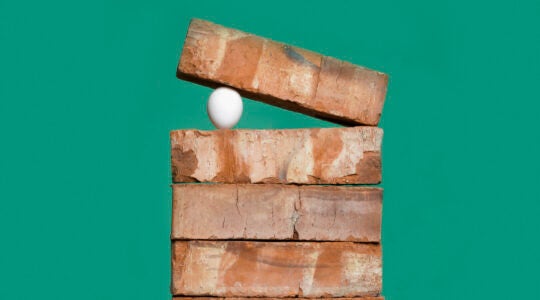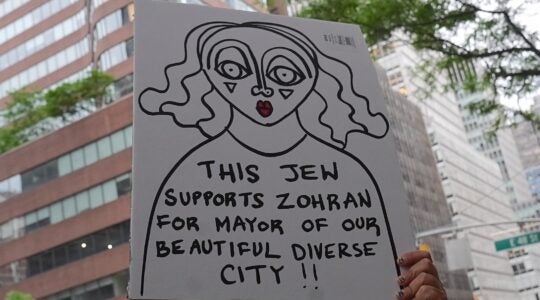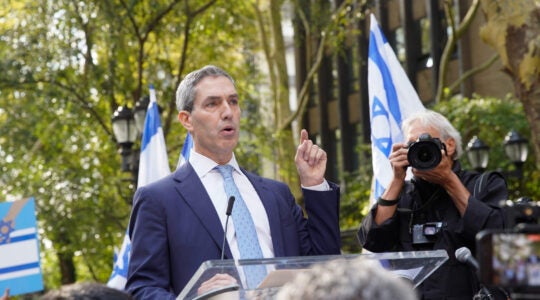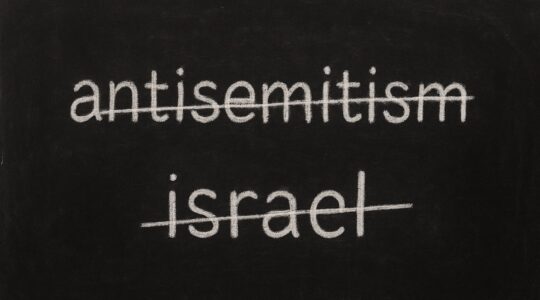Did you chant a Haftorah at your bar or bat mitzvah?
Do you remember what it was about?
Have you chanted any others since then?
Rabbi Joy Levitt, executive director of the JCC in Manhattan, believes that the heavy emphasis on teaching youngsters to chant a Haftorah on their special days is a sign of “wasted training and the wrong message” for bar and bat mitzvah youngsters.
“We’re not preparing them for Jewish life” with such rituals, she says. “On the contrary, we’ve sabotaged their Jewish life.”
Strong words, but Rabbi Levitt has given the subject a lot of thought, based on her observations of many years as a pulpit rabbi and officiating at hundreds of coming-of-age ceremonies.
And she is not alone in her critique of many bar and bat mitzvah services that emphasize mastery of a particular element of the service — frequently based on memorization — rather than a wider understanding of what it means to become an adult, Jewishly.
Sally Gottesman, chair of Moving Traditions, a national organization that encourages teens to engage more deeply in Judaism, says our community should be making bar and bat mitzvah “a rite of passage into something rather than from something.”
For too many youngsters, the big day marks the end of formal Jewish education rather than a transition into Jewish adulthood and an advanced stage of learning and identity.
“Kids don’t really focus on what it means to be a Jewish adult or to join the Jewish community,” says Gottesman, who suggests having bar and bat mitzvah youngsters engage in serious conversations about what it means to be part of the community with five adults they admire.
What prompted Gottesman’s observations was an exhibit that Moving Traditions created to mark the 90th anniversary of the first bat mitzvah ceremony. Now showing at the JCC in Manhattan (through April 27) before touring the country, the exhibit is entitled “Bat Mitzvah Comes of Age” and chronicles a series of “firsts” among 150 pioneers of the now widely accepted ritual, from first Saturday morning bat mitzvah, to first to read Torah to first adult bat mitzvah. (See Gottesman’s Opinion piece on page 21.)
The research and preparation for the exhibit motivated Gottesman to think about how religious rites of passage evolve, and how they could be changing in creative ways to meet the times.
It’s long been a cliché and embarrassment that so many bar and bat mitzvahs in America are marked by excessive spending, with elaborate themed parties that have little or no religious content. Part of why the post-bar and bat mitzvah festivities tend to eclipse the religious ceremony itself may be because the synagogue service often has little meaning for the youngster in the spotlight. For most, the Hebrew prayers tend to be recited without full understanding of the words themselves or their significance, and the Haftorah reading is a segment from the Prophets seemingly unconnected to the narrative that comes before and after.
“The irony is that the words of the prophets, which were supposed to stir the people, now puts them to sleep,” says Rabbi Levitt.
Look around the synagogue during the youngster’s chanting of the Haftorah, she says. “It’s narcolepsy.”
Rabbi Levitt acknowledges that the accomplishments of the bar or bat mitzvah child in learning to lead part of the Shabbat service are significant psychologically and deserve praise.
“On that day the loving parents look on in amazement that their child can do something so difficult,” she said. “It’s like climbing a mountain and feeling good about yourself, and the parents are delighted.”
But she says the emphasis on having youngsters spend many months learning the trop, or cantillation, of the Haftorah, often through personalized training, is a waste of time and effort, teaching the youngsters “something they don’t need to know and won’t remember in a year.”
What’s more, she points out, the one-on-one Haftorah lessons may well be the only time in the child’s life that he or she will have such an intense Jewish educational experience. Why, then, devote it to such a narrow purpose?
Many synagogues now encourage chesed projects for bar and bat mitzvah youngsters to perform, but Rabbi Levitt would like to see the emphasis shift from the individual to the communal level.
It’s all well and good for the children to raise funds for poor people, often in distant countries, she says, but she thinks it is more appropriate in Jewish schools for seventh and eighth graders — the age of bar and bat mitzvah children — to engage in class projects that they can work on together rather than further promote the sense of individual accomplishment associated with our coming-of-age ritual.
Whether or not you’re on board with the specifics of these observations, I hope you agree that it’s important to step back and re-think what message we want to convey to the next generation in preparing them, at a tender age, to become members of our community.
Why should they continue their Jewish education if what we have taught them until now doesn’t seem relevant to their lives or inspire them to dig deeper into their Jewish identity?
We need to make the most of this precious time in our children’s lives, instilling them with the creativity, passion and majesty of Jewish life rather than settling for ceremonies devoid of meaning to them.
For starters, let’s make the bar and bat mitzvah experience less about memorization and more about participation.
E-mail: Gary@jewishweek.org
The New York Jewish Week brings you the stories behind the headlines, keeping you connected to Jewish life in New York. Help sustain the reporting you trust by donating today.





